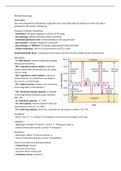Samenvatting
Samenvatting van alle colleges van Medical Physiology
- Instelling
- Rijksuniversiteit Groningen (RuG)
Alle aantekeningen van de colleges van het vak Medical Physiology. Er zitten ook twee bladen met alle formules bij die heel handig zijn om te stampen voor het tentamen!
[Meer zien]




